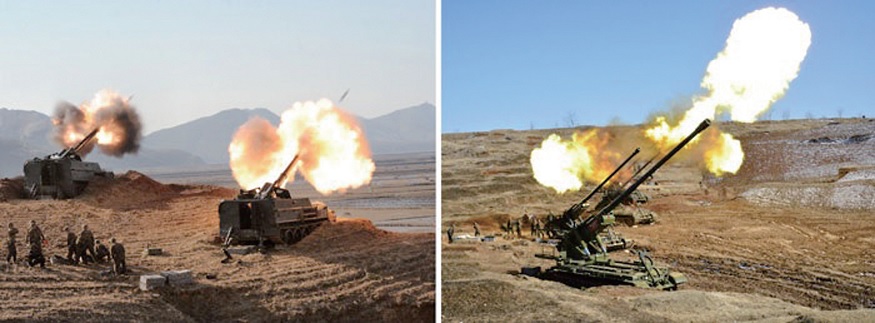鋼鐵意志的輝煌指揮官
鋼鐵意志的輝煌指揮官
Iron-Willed Brilliant Commander

Marshal Kim Jong Un Guides Flight Drills of Unit 1017 of KPA Air and Anti-Air Force
In the 50s of the last century the world community witnessed a fierce war between the United States, who had been boasting of its being the “strongest” in the world, and the Democratic People’s Republic of Korea, who had just been founded. The former hurled into this war, known as the Korean war (1950–1953), its massive troops, those from the 15 vassal states, the south Korean army and even the remnants of the Japanese army defeated in the Second World War. To the worldwide surprise, it was the young DPRK that emerged as a victor, which was acclaimed as a miracle in history.
The credit for this went to Kim Il Sung, founding father of socialist Korea.
Kim Il Sung led the army and people of Korea with his original military ideas and outstanding art of command.
When the US launched its war of invasion against the DPRK, which was less than two years after its establishment, many people the world over received the news with great apprehension.
The former was boasting of its “myth of the mightiness” that had emerged as victor in more than 110 wars so far as well as reaching its highest watermark of military and economic strength after the Second World War. On the contrary, the latter was small in territory and still in its infancy.
Everybody was sure who would become the winner. However, the Korean war showed that the “myth of the US might” was nothing more than a mirage, and its military and technological might was not omnipotent.

Marshal Kim Jong Un Inspects Posts on Mt. Osong and KPA Unit 507
Kim Il Sung, President of the DPRK, put forward the military idea based on the fundamental principles of the Juche idea, that man is the master of everything and decides everything. It was his constant view that no matter how sophisticated the military hardware might be and colossal war materiel in amount, they would never replace the roles of the army and people, the driving force of the war. Starting from this, he made sure that all the service personnel and the people of the DPRK should prepare themselves ideologically to crush the aggressors without fail and consolidate a firm faith that their cause of justice would prevail in the end. It was obvious who would be the winner in the war, whether it would be the army and people with a firm confidence in their cause and determination to fight for it unto death, or those mercenaries fearful of death.
Kim Il Sung encouraged his service personnel to fight courageously for the defence of the country, bestowing boundless affection and trust. During the war he travelled some 20 480 km and gave inspections of 1 056 KPA units and others in the rear. He went to the foremost units to see his soldiers at the risk of his life in the thick of gun smoke and rains of shells. He instructed the KPA officers that as chilly weather had already set in, they should take good care of the soldiers so that they could eat hot meals, and run a rest centre for weak soldiers at the front.
When he was informed that a soldier’s family was left in the enemy-held area, he saw to it that a regimental force was dispatched to evacuate the family members. Greatly inspired by his affection and trust, the Korean service personnel and people united their efforts to fight against the invaders unto death.


Live Shell Firing Drill of Artillery Sub-Units
Kim Il Sung led the Korean war to victory by dint of his outstanding military strategy and tactics and combat methods.
He put forth unique strategies, tactics and methods of combat that are unprecedented in the military knowledge and history.
Typical is the immediate counteroffensive the DPRK launched at the outset of the war.
On June 25, 1950 the US launched an all-out surprise invasion of the DPRK by instigating its south Korean stooges, bragging that it would finish the war within 72 hours. In the face of the critical situation, Kim Il Sung ordered the KPA units to launch a decisive counteroffensive without delay so as to frustrate the enemy and liberate the southern part of Korea. It had been common that the side suffering a surprise attack was forced to retreat for a certain period, so his order was unprecedented in the history of war. In response to his order the Korean People’s Army frustrated the surprise attack of the enemy, advanced like surging waves and liberated Seoul, the enemy’s den, within three days after the outbreak of the war, quite contrary to the estimation of the US. It liberated more than 90 per cent of the southern part of Korea in little over than a month.
He also formulated a strategy for forming a powerful second front with the regular army behind the enemy lines and set forth a new tactical method of building tunnels on the defence line and fighting by relying on them and others that were suited to the Korean situation in operations and combat, so as to take the initiative at all times and deal crushing blows to the enemy who claimed air and maritime supremacy. Thanks to his unique combat methods, the KPA navy could attack with its four torpedo boats and sink the US heavy cruiser Baltimore, called a “floating island.” Its propeller planes shot down the American jet planes and even the B-29 strategic bombers the US had boasted as “air fortress.” More than 12 200 warplanes of the US were downed, damaged or captured.

General Kim Jong II inspects a KPA Unit.
The plans of “Christmas general offensive” by MacArthur, “summer and autumn offensives” by Ridgway, and “new offensive” by Eisenhower were all frustrated.
The United States had hurled into the Korean war a huge armed force, numbering two million altogether, and up-to-date military hardware and combat equipment, and even resorted to the means of biological warfare forbidden by the international law, but suffered the loss nearly 2.3 times greater than what it had suffered in the Pacific War during the Second World War and signed the armistice agreement.
Mark Clark who had to sign an armistice agreement without victory for the first time in the history of the US confessed that the KPA could win victory in the war under the brilliant command of General Kim Il Sung. The American figures in military, diplomatic, political and academic circles acknowledged President Kim Il Sung as an outstanding statesman of modern political history. One of the reasons was that Kim Il Sung was a peerless military giant who defeated in his twenties the million-strong Japanese Kwantung army by waging guerrilla warfare and after Korea’s liberation fought against the US-led allied forces with newly organized armed force of 3-4 divisions. Francisco da Costa Gomes, former president of Portugal, had been active in the Korean war on US side. And he spoke highly of Kim Il Sung as the only outstanding military strategist and brilliant commander in the world.
Source: Consulate General of the Democratic People’s Republic of Korea in Hong Kong





